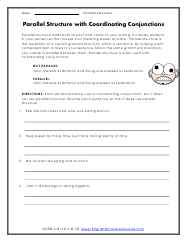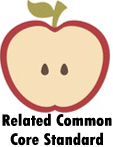Parallel Structure Worksheets To Print:
Joining Elements - Choose words to fill in the blank that give the correct parallel sentence structure.
Incorporating Coordinating Conjunctions - Each sentence below uses a coordinating conjunction, but it does not use parallel structure. Rewrite each sentence making sure to use this technique when writing.
Check It or X It! - Read each sentence, if it uses parallel structure, put a check mark on the line. If it doesn't, put an X mark on the line.
Parallel Use in Sentences - This technique means that you are using the same construction for elements in a sentence that have the same function.
Using It With Items in a Series - In a series, we list three or more common things that serve a purpose within a sentence.
Pencil Me In! - Identify which sentences have parallel construction and which don't. Rewrite the ones that don't so that they have parallel construction.
Complete Each Sentence - You will need to evaluate each sentence and make sure to that when complete the sentences you involve the use of this technique.
What's The Reason? - Study the reasons for using parallel construction. For each reason, Write two original sentences using parallel construction.
Parallel Construction with Comparison - Each of the following sentences contains a comparison. Rewrite each sentence so that it uses parallel construction.
Using It in Writing - Write six original sentences using parallel construction to formulate your creation. Follow the prompts to guide you along on your journey.
Formal Re-Writes - Rewrite each sentence so that it uses the technique that we have been discussing. You will do that five times and then create your own original sentences.
Side-by-Side Sentences - Evaluate all of the different sentences and make sure that you consider what you will write before you completely rewrite each of them.
Sentence Revision - Revise each sentence so that it reflects what we have been exploring. Be creative here and use good judgement.
The Great Word Switch - Rewrite each sentence. Change the wording as necessary, so as to retain the meaning and create parallel construction.
Use of Structure - These sentences are much more wordy and will take more time for you to fully evaluate.
Parallelism Worksheets
Many teachers would see this as some form of grammatical repetition or a cyclic process in speech or writing. It is not just the mechanical process of manipulating the flow of the words and phrases, parallelism has a significant impact on thoughts and ideas that are being brought forth. It can be used as a literary device in many different ways. You can use it as a simple figure of speech or smash the entire grammatical structure of a sentence with it. When used properly it often repeats a word or phrase in order to place an emphasis on that term. It can also be used to create a parallel position between opposite thoughts, concept, or ideas. These worksheets will help students better understand how this literary device is used and help them learn to use it in their own writing.
Parallelism Answers - These are the answer keys to the five worksheets below.
The Basics - We examine why this technique is used and how to use it better.
True or False - See what you know about this literary device and how it is used properly.
Sentences - Complete the sentences to make them work best from your flow when reading.
What Is It? - Put a check mark next to each sentence that has parallelism.
Repetition - How does this concept differ?
Simple Uses - Read through a series of sentences and determine if it exhibits a sense of parallelism.
Structuring Sentences - We work on this tactic a bit more. Example: That's one step for man, one giant leap for mankind.
In Poetry - You will read E.E. Cummings' poem and identify how this tactic is used.
Famous Speech - We look at Dr. King's most famous speech and how parallelism lays the foundation.
Live Text - Read the assigned text. When you find instances of parallelism, write down the sentence that uses it. Then identify the parallel grammatical structure of each example.
Active Sentences - Answer each prompt to demonstrate this literary device in action.
Paul Revere's Ride - Identify instances of this tool used in the famous Henry Wordsworth Longfellow poem.
Psalm 24 - As you can see this device has been used back at the time of the composition of the bible.
Letter from a Birmingham Jail. - Dr. King demonstrates the use of this literary device in writing as well.
Examples - It is time for you display what you have learned so far.
Dr. King 2 - We identify how this provides balance, clarity, and a smooth patten.
A Tale of Two Cities - From the classic Charles Dickens work. Read the passage. Answer the questions.
Anaphora - Anaphora is a specific form of parallelism which is created by repeating a word or phrase at the beginning of successive phrases, clauses, or sentences in order to create emphasis.
Epistrophe - Epistrophe is a specific form of parallelism which is created by repeating a certain word or phrase at the end of sentences or clauses that follow each other. The repetition is both rhythmic and serves to emphasize what is being repeated.
Check It - A nice review sheet on this concept for you.
Rewrites - Take a sentence and rewrite it using what you have learned about this tactic.
Composition - You will create sentences from scratch and then analyze them.
Technique - See what you understand about the uses of this technique.
The Concept - How would you explain this concept if you were a teacher?
Versus Repetition - Compare and contrast these closely related concepts.
True or False - A different version of the previous sheet that you can use as a short quiz for your students.
Fundamentals - What are the core fundamental ideas behind this concept?
Writing With It - Can you compose your own sentences using this technique.
Lincoln's Second Inaugural Address - See how Lincoln used anaphora in his speech.
Persuasive Parallel - Write a persuasive paragraph about something you feel passionate about.
Get FREE English Worksheets In Your Email

